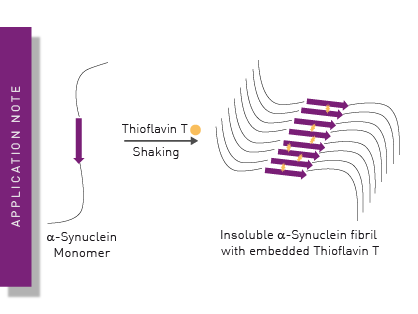
Peptidic inhibitors of α-Synuclein preventing Parkinson’s disease-associated fibrilization and cytotoxicity
Read here how peptidic inhibitors of α-Synuclein nucleation and fibril elongation can be evaluated on microplate readers.


Neuroscience focuses on the brain, the nervous system, how neurons function in different organisms, diseases and much more. Discover how BMG LABTECH microplate readers can advance neuroscience research.
The aetiology of neurodegenerative diseases such as Alzheimer’s disease, Parkinson’s disease, dementia and Creutzfeldt-Jakob disease are still not fully understood, and most existing drugs only treat symptoms. Further understanding of the molecular processes in particular the triggers and early stages of the disease are important to identify potential new drugs. Plate readers can help clarify mechanisms and to identify new drugs.
The disruption of mitochondrial function is known to be linked to neurodegenerative diseases. The presence and progressive accumulation of specific protein aggregates in the brain is the most defining feature across all major neurodegenerative diseases. Aggregation-prone proteins include α-synuclein, amyloid-β, tau, prion and polyglutamine-containing proteins. Solving the molecular basis of protein misfolding and aggregation is a crucial step towards the comprehension of the factors that trigger the onset of these diseases and for the development of efficient therapeutical strategies. One of these could be the development of inhibitors of aggregation as highlighted in the application note ‘Peptidic inhibitors of α-Synuclein that prevent Parkinson-associated fibrilization and cytotoxicity’.
Besides human health, prion research has also an economic relevance as transmissible spongiform encephalopathies do not only affect humans but also livestock such as cattle and sheep.
Explore the content below to understand how BMG LABTECH instruments can support research in neurobiology including aggregation assays, viability assays and toxicity assays to assist in understanding neuronal death and in degeneration biomarker quantification. Microplate readers can also be used to analyse hyper-bilirubinemia levels to determine the risk of encephelopathy.
Browse our resources section for information about specific applications, literature citations, videos, blog articles and many other publications. Many of the resources provided are associated with current and previous instrument models and versions.
Read here how peptidic inhibitors of α-Synuclein nucleation and fibril elongation can be evaluated on microplate readers.
Are you looking for new tools for Alzheimer's diagnosis? Read here how phospho-tau modifications can be detected with ELISAs and potentially used as biomarkers.
The Alzheimer targets tau, BDNF and TREM2 can be accurately quantified in 90 minutes using abcam’s SimpleStep ELISAs and the SPECTROstar® Nano. Read more in this AppNote.
Detect even prefibrillar protein aggregates with high sensitivity combining fluorescence polarization, the fluorophore TPE-TPP and the CLARIOstar microplate reader.
Tau protein aggregation can´t only be measured using thioflavin fluorescence. Take a look at this application note, which highlights a TR-FRET-based immunoassay for the detection of tau aggregates.
Aβ aggregation is a fundamental hall-mark for Alzheimer’s disease. Find out, why the long-term shaking capabilities of BMG LABTECH readers are essential for monitoring Aβ aggregation events.
Neurodegenerative disease ultimately leads to the death of neurons as neuronal functions deteriorate. Find out how microplate readers can be used to study neuronal cell death and its link to neurodegenerative disease.
The disruption of mitochondrial function is linked to neurodegenerative diseases. Find out how microplate readers advance research into mitochondrial dysfunction and neurodegenerative diseases.
The way proteins misfold and aggregate is linked to many neurodegenerative diseases. Find out how microplate readers can help advance research into protein misfolding.
Alpha-synuclein is a key protein involved in neurodegenerative diseases like Parkinson’s. Find out how microplate readers can help advance alpha-synuclein research.
Amyloids are thought to play a crucial role in neurodegeneration. Find out how microplate readers help advance amyloid research.
The tau protein plays a role in many neurological diseases and disorders. Find out about neuronal toxicity induced by tau and how microplate readers can aid tau research.
The RT-QuIC assay helps to study prions and is an alternative to cost and time intensive animal studies. Learn how to optimize sensitivity and specifity.
Marcus Hanley from Cardiff University explains how the PHERAstar FSX and its software support drug discovery in neuroscience.
Emma Murphy from ARUK Oxford Drug Discovery Institute talks about her work with Alzheimer's and Parkinson's diseases and how Plate Reader can help her.
Florian Kohn from the University of Hohenheim explains how a microplate reader can help at a microplate-based assay on parabolic flight at zero gravity.
Powerful and most sensitive HTS plate reader
Most flexible Plate Reader for Assay Development
Upgradeable single and multi-mode microplate reader series